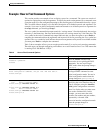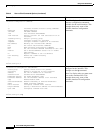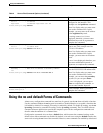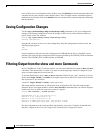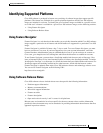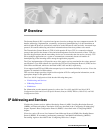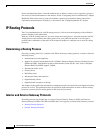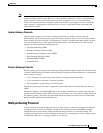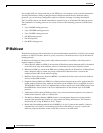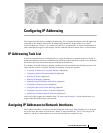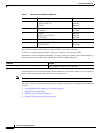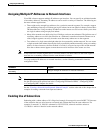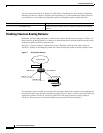
IP Overview
IP Routing Protocols
IPC-3
Cisco IOS IP Configuration Guide
Note Many routing protocol specifications refer to routers as gateways, so the word gateway often appears
as part of routing protocol names. However, a router usually is defined as a Layer 3 internetworking
device, whereas a protocol translation gateway usually is defined as a Layer 7 internetworking
device. The reader should understand that regardless of whether a routing protocol name contains the
word “gateway,” routing protocol activities occur at Layer 3 of the Open System Interconnection
(OSI) reference model.
Interior Gateway Protocols
Interior gateway protocols are used for routing networks that are under a common network
administration. All IP interior gateway protocols must be specified with a list of associated networks
before routing activities can begin. A routing process “listens” to updates from other routers on these
networks and broadcasts its own routing information on those same networks. Cisco IOS software
supports the following interior routing protocols:
• On-Demand Routing (ODR)
• Routing Information Protocol (RIP)
• Interior Gateway Routing Protocol (IGRP)
• Open Shortest Path First (OSPF)
• Enhanced IGRP (EIGRP)
• Integrated IS-IS
Exterior Gateway Protocols
Exterior gateway protocols are used to exchange routing information between networks that do not share
a common administration. IP Exterior Gateway Protocols require the following three sets of information
before routing can begin:
• A list of neighbor (or peer) routers with which to exchange routing information
• A list of networks to advertise as directly reachable
• The autonomous system number of the local router
The exterior gateway protocol that is supported by Cisco IOS software is Border Gateway Protocol
(BGP).
Multiprotocol BGP is an enhanced BGP that carries routing information for multiple network-layer
protocols and IP multicast routes. BGP carries two sets of routes, one set for unicast routing and one set
for multicast routing. The routes associated with multicast routing are used by Protocol Independent
Multicast (PIM) to build data distribution trees.
Multiple Routing Protocols
You can configure multiple routing protocols in a single router to connect networks that use different
routing protocols. You can, for example, run RIP on one subnetted network and IGRP on another
subnetted network, and exchange routing information between them in a controlled fashion. The
available routing protocols were not designed to interoperate, so each protocol collects different types
of information and reacts to topology changes in its own way.



